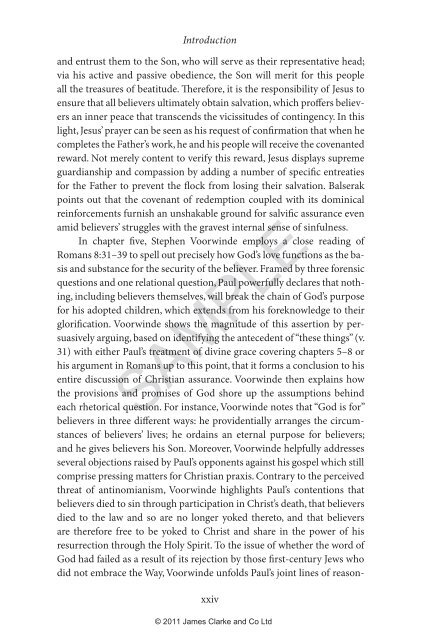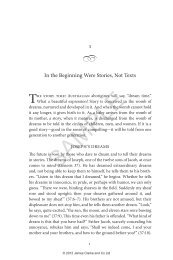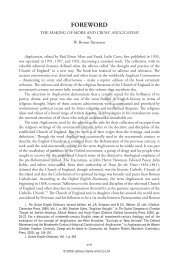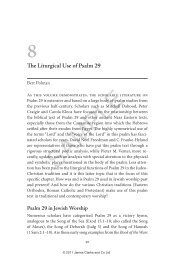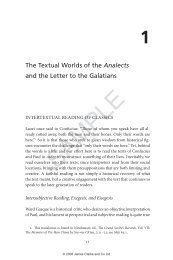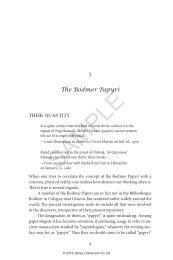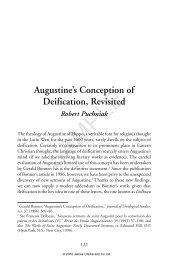Introduction by Kirk R. MacGregor - James Clarke and Co Ltd
Introduction by Kirk R. MacGregor - James Clarke and Co Ltd
Introduction by Kirk R. MacGregor - James Clarke and Co Ltd
You also want an ePaper? Increase the reach of your titles
YUMPU automatically turns print PDFs into web optimized ePapers that Google loves.
<strong>Introduction</strong><br />
<strong>and</strong> entrust them to the Son, who will serve as their representative head;<br />
via his active <strong>and</strong> passive obedience, the Son will merit for this people<br />
all the treasures of beatitude. Therefore, it is the responsibility of Jesus to<br />
ensure that all believers ultimately obtain salvation, which proffers believers<br />
an inner peace that transcends the vicissitudes of contingency. In this<br />
light, Jesus’ prayer can be seen as his request of confirmation that when he<br />
completes the Father’s work, he <strong>and</strong> his people will receive the covenanted<br />
reward. Not merely content to verify this reward, Jesus displays supreme<br />
guardianship <strong>and</strong> compassion <strong>by</strong> adding a number of specific entreaties<br />
for the Father to prevent the flock from losing their salvation. Balserak<br />
points out that the covenant of redemption coupled with its dominical<br />
reinforcements furnish an unshakable ground for salvific assurance even<br />
amid believers’ struggles with the gravest internal sense of sinfulness.<br />
In chapter five, Stephen Voorwinde employs a close reading of<br />
Romans 8:31–39 to spell out precisely how God’s love functions as the basis<br />
<strong>and</strong> substance for the security of the believer. Framed <strong>by</strong> three forensic<br />
questions <strong>and</strong> one relational question, Paul powerfully declares that nothing,<br />
including believers themselves, will break the chain of God’s purpose<br />
for his adopted children, which extends from his foreknowledge to their<br />
glorification. Voorwinde shows the magnitude of this assertion <strong>by</strong> persuasively<br />
arguing, based on identifying the antecedent of “these things” (v.<br />
31) with either Paul’s treatment of divine grace covering chapters 5–8 or<br />
his argument in Romans up to this point, that it forms a conclusion to his<br />
entire discussion of Christian assurance. Voorwinde then explains how<br />
the provisions <strong>and</strong> promises of God shore up the assumptions behind<br />
each rhetorical question. For instance, Voorwinde notes that “God is for”<br />
believers in three different ways: he providentially arranges the circumstances<br />
of believers’ lives; he ordains an eternal purpose for believers;<br />
<strong>and</strong> he gives believers his Son. Moreover, Voorwinde helpfully addresses<br />
several objections raised <strong>by</strong> Paul’s opponents against his gospel which still<br />
comprise pressing matters for Christian praxis. <strong>Co</strong>ntrary to the perceived<br />
threat of antinomianism, Voorwinde highlights Paul’s contentions that<br />
believers died to sin through participation in Christ’s death, that believers<br />
died to the law <strong>and</strong> so are no longer yoked thereto, <strong>and</strong> that believers<br />
are therefore free to be yoked to Christ <strong>and</strong> share in the power of his<br />
resurrection through the Holy Spirit. To the issue of whether the word of<br />
God had failed as a result of its rejection <strong>by</strong> those first-century Jews who<br />
did not embrace the Way, Voorwinde unfolds Paul’s joint lines of reason-<br />
SAMPLE<br />
xxiv<br />
© 2011 <strong>James</strong> <strong>Clarke</strong> <strong>and</strong> <strong>Co</strong> <strong>Ltd</strong>


